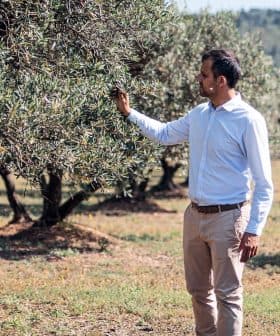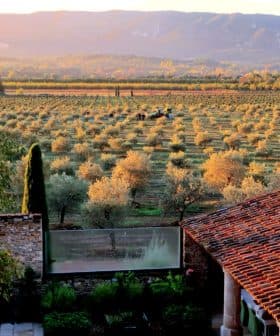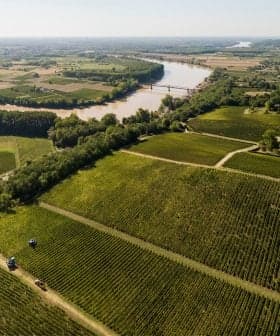Moulin de Villevieille, Pride of the Garrigues
The Moulin de Villevieille, a small extra virgin olive oil co-operative in southern France, has achieved success through strict production standards and a focus on quality. The co-operative has received industry recognition for its olive oils and emphasizes the importance of passion and tradition in its production process.
By Lindsey Partos
Olive Oil Times Contributor | Reporting from Paris
A tough set of production standards coupled with a strident pursuit for quality have brought accolades and growth for the Moulin de Villevieille, a small extra virgin olive oil co-operative in the heart of the rosemary-scented garrigues in southern France.
Located at the apex of a triangle between Montpellier and Nimes, the moulin (mill) is annually fed by 1,600 local producer-members and sits snugly aside the attractive, medieval market town of Sommières.
.
 Quality calibrates each chink in the production chain at the ancient mill. “We don’t want mass production. Our ambition is that the producers keep the history of the olive trees alive. Everyone has sweated over these trees, we want to keep the sweat,” underlines Bruno Ferriers, master olive oil maker at the Villevieille mill.
Quality calibrates each chink in the production chain at the ancient mill. “We don’t want mass production. Our ambition is that the producers keep the history of the olive trees alive. Everyone has sweated over these trees, we want to keep the sweat,” underlines Bruno Ferriers, master olive oil maker at the Villevieille mill.
And the co-operative’s ceaseless drive towards added-value has earned industry-wide recognition. In 2008 the International Olive Council rewarded the mill with first prize in its Mario Solinas Awards ‘medium ripe fruitiness’ category, while in 2009 Villevieille’s AOC Nimes extra virgin olive oil walked off with a silver medal.
.
 Arguably the backbone for quality at the mill is the strict cahier de culture for producers and the co-operative’s rigorous approach to traceability. Details of how much water, fertilizer, insecticide and other contributory factors are inked into the cahier, and all members are required to present this record book when they deliver their bounty. Ferriers says he will refuse olives should the cahier highlight anomalies and ‘unacceptable products, and he is always on the look out for natural solutions.
Arguably the backbone for quality at the mill is the strict cahier de culture for producers and the co-operative’s rigorous approach to traceability. Details of how much water, fertilizer, insecticide and other contributory factors are inked into the cahier, and all members are required to present this record book when they deliver their bounty. Ferriers says he will refuse olives should the cahier highlight anomalies and ‘unacceptable products, and he is always on the look out for natural solutions.
Production works on a ratio of approximately one tree to one bottle of oil, according to the oil maker, so one tree reaps about five kilos of olives, with five kilos of olives producing one litre of oil. But Ferriers suggests that higher yields could be in sight: “There is room for improvement, I think we can go up to ten kilos a tree. But I will not push our producers to go to mass production, with more fertilisers et al.”
The profile of producers for the mill is certainly eclectic, ranging from civil servants to farmers, librarians to mechanical engineers. Passion, rather than cash, seems to be the driving force. Producers receive about 7 to 9 euros per litre (around 9 to 12 dollars).
 “Not one of our members lives off their olive oil,” said Ferriers, further exclaiming, “when I first arrived, it was the passion that hit me!”
“Not one of our members lives off their olive oil,” said Ferriers, further exclaiming, “when I first arrived, it was the passion that hit me!”
Small, artisanal holdings mark the typical Villevieille co-operative producer. “Our members produce anything from just one kilo to one tonne of olives,” explains the oil maker. “These are not the huge orchards like in Spain,” he adds.
Members are staked out in a ‘grand triangle’ pegged out from Nimes in the east, Ales in the north and Montpellier to the west. “This is the wealth of our co-operative, it is rich in people and diversity,” Ferriers proudly states.
 Squarely marketed as a premium extra virgin olive oil, Villevieille’s range of “grand crus” cost between 15 and 20 euros ($20 to $27) a bottle. Ferriers is mindful that in a pressing economic climate, price plays a bigger role, particularly with a fall in consumer purchasing power. “This is one of the challenges with an expensive, quality product.”
Squarely marketed as a premium extra virgin olive oil, Villevieille’s range of “grand crus” cost between 15 and 20 euros ($20 to $27) a bottle. Ferriers is mindful that in a pressing economic climate, price plays a bigger role, particularly with a fall in consumer purchasing power. “This is one of the challenges with an expensive, quality product.”
Each olive growing region in France has its specific varieties. The lucques variety is prevalent in the Herault and Aude departments, for example. At Villevieille, an olive press since 1929, they have ‘always worked’ the picholine and négrette varieties.
The mill’s grand crus include the deep golden and fully-flavoured picholine extra virgin olive oil with its notes of red fruit. Picholine is the mill’s number one oil: the co-op produces about 60 to 70,000 litres of picholine each year out of a total annual olive oil output of 100,000 litres. In addition, the mill produces the soft, fruity négrette oil, the green-hued aglandau oil which bears ‘vegetable’ notes, along with small quantities of antan and bouteillan olive oil varietals.
Completing the portfolio is the co-operative’s freshly rubber-stamped AOC Nimes olive oil. A picholine and négrette blend, the AOC (Appellation d’Origine Contrôlée) law dictates the “AOC Extra Virgin Olive Oil of Nimes” must contain a minimum of 60% picholine.
The master miller and his many co-operative members have an ardent attachment to the olive tree’s terroir — the notion of land, climate and tradition. Perhaps they might argue that this deep passion today translates into the superior, complex and flavorsome extra virgin olive oils that fly off the shelves at the eighty-year old Villevieille co-operative.
Villevieille
The landscape today at the Villevieille mill is in direct contrast to depressing context nearly fifty years ago. One destructive night in february 1956 a fierce frost wiped-out olive oil orchards in this booming production area. In one foul stroke, the temperature plunged from 21 degrees in daytime, to a painful minus 17 degrees. Sun-seeking sap that had crept up the trees as the temperature climbed to hot heights was totally frozen in its tracks.
Legend has it that on the day following the frost the sound of olive trees crying pervaded the orchards as the sap exploded and cracked the trees. While more than 100 olive oil producers existed prior to the frost, after jack frost clicked his heels, only three remained. Villevieille was one of the survivors. But the cruel free fall in temperature dealt the death knoll for olive trees. Twenty years passed before the trees, heavily pruned after the frost, bore fruit.
Pre-1956 olive oil was a daily fixture in the kitchens of local populations, indeed the main source of fat for communities in southern France. After, the frost would shape how locals consumed their fat, switching from olive oil to other sources. Only in recent years has the tide started to turn again. In pre-frost 1956 the area produced about 1,000 tonnes of olives. Today, production has climbed its way back to approximately 900 tonnes.
Moulin de Villevieille, Cooperative Oleicole de Sommiers
154 Avenue des Cevennes
30250 VILLEVIEILLE, France









